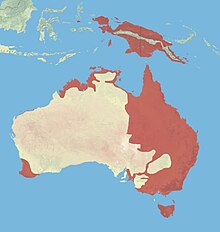Hydromys chrysogaster
| Rakali | |
|---|---|
 |
|
| Scientific classification | |
| Kingdom: | Animalia |
| Phylum: | Chordata |
| Class: | Mammalia |
| Order: | Rodentia |
| Family: | Muridae |
| Genus: | Hydromys |
| Species: | H. chrysogaster |
| Binomial name | |
|
Hydromys chrysogaster Geoffroy, 1804 |
|
 |
|
| Distribution of the water rat | |
Hydromys chrysogaster, commonly known as rakali, rabe or water-rat, is an Australian native rodent first described in 1804. The change to the aboriginal name Rakali was intended to foster a positive public attitude by Environment Australia. It is the only member of the genus Hydromys with a range extending beyond Papua New Guinea and Indonesian West Papua. Having effectively adapted and colonised a unique niche of semi-aquatic and nocturnal lifestyle. This species lives in burrows on the banks of rivers, lakes and estuaries and feeds on aquatic insects, fish, crustaceans, mussels, snails, frogs, birds' eggs and water birds. Rakali have a body 231–370 millimetres (9.1–14.6 in) in length, weigh, 340–1,275 grams (0.750–2.811 lb) and have a thick tail measuring around 242–345 millimetres (9.5–13.6 in). Females are generally smaller than males but tail lengths are normally the same.They have partially webbed hind legs, waterproof fur, a flattened head, a long blunt nose, many whiskers and small ears and eyes. The body is streamlined with a skull that is large, flat and elongated, with two molars on the upper and lower jaw, similar to the False water rat Xeromys meroides. They are black to brown in colour with an orange to white belly, and dark tail with a white tip.
Hunted for their soft fur and considered a nuisance animal, numbers were under threat until a protection order in 1938. They were still under destruction permits from 1938 to 1957 due to alleged destruction of irrigation banks and destruction of fishing nets. Additionally from 1957 to 1967 a number of licensed season were also held for this reason.
Until the 1980s, this species was commonly known as "water-rat", but during the 1990s there was a push for such descriptive English common names to be replaced with indigenous names. In 1995 the Australian Nature Conservation Agency released a document in which the following indigenous names were recorded for H. chrysogaster. They recommended that "rakali" be adopted as the common name, and the Australian Department of Environment and Heritage has taken up this suggestion. Both common names are now widespread.
...
Wikipedia

